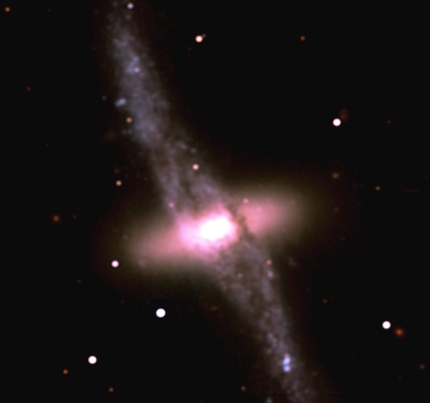Credit & Copyright: Very Large Telescope Project,
ESO
Explanation:
This
strangely distorted galaxy of stars is cataloged as NGC 4650A.
It lies about 165 million light-years away in the southern
constellation Centaurus.
The complex system seems to have at least two parts,
a flattened disk of stars with a dense, bright, central core and
a sparse, sharply tilted
ring of gas, dust and stars.
Observations show that the stars in the disk
and the stars and gas in the
ring really do move in two different, nearly perpendicular planes,
probably as the result of a
past galaxy vs. galaxy collision.
The observed motions within both disk and ring also indicate the
presence of "dark matter" - an unseen source of gravity which
influences the movement of this system's visible stars.
Over the decades evidence that
our Universe is largely
composed of such dark matter has grown while the
nature of dark matter has
remained a profound astrophysical mystery.
The picture was constructed from images made using part of
the European Southern Observatory's (ESO) new
Very Large Telescope system now undergoing
its testing phase.
1999 2000 2001 2002 2003 2004 2005 2006 2007 2008 2009 2010 2011 2012 2013 2014 2015 2016 2017 2018 2019 2020 2021 2022 2023 2024 2025 |
Yanvar' Fevral' Mart Aprel' Mai Iyun' Iyul' Avgust Sentyabr' Oktyabr' Noyabr' Dekabr' |
NASA Web Site Statements, Warnings, and Disclaimers
NASA Official: Jay Norris. Specific rights apply.
A service of: LHEA at NASA / GSFC
& Michigan Tech. U.
|
Publikacii s klyuchevymi slovami:
dark matter - colliding galaxies - vzaimodeistvuyushie galaktiki - temnaya materiya - Ochen' Bol'shoi Teleskop
Publikacii so slovami: dark matter - colliding galaxies - vzaimodeistvuyushie galaktiki - temnaya materiya - Ochen' Bol'shoi Teleskop | |
Sm. takzhe:
Vse publikacii na tu zhe temu >> | |
